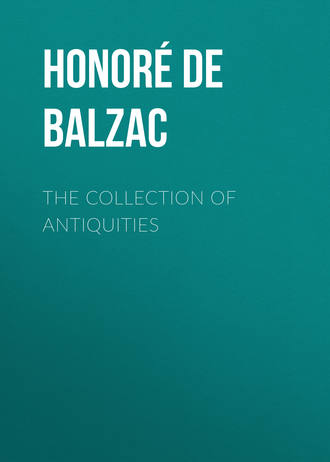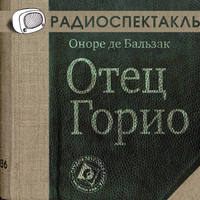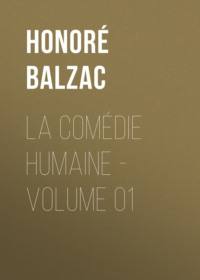 полная версия
полная версияThe Collection of Antiquities

Honoré de Balzac
The Collection of Antiquities
DEDICATION
To Baron Von Hammer-Purgstall, Member of the Aulic Council, Author of the History of the Ottoman Empire.
Dear Baron, – You have taken so warm an interest in my long, vast “History of French Manners in the Nineteenth Century,” you have given me so much encouragement to persevere with my work, that you have given me a right to associate your name with some portion of it. Are you not one of the most important representatives of conscientious, studious Germany? Will not your approval win for me the approval of others, and protect this attempt of mine? So proud am I to have gained your good opinion, that I have striven to deserve it by continuing my labors with the unflagging courage characteristic of your methods of study, and of that exhaustive research among documents without which you could never have given your monumental work to the world of letters. Your sympathy with such labor as you yourself have bestowed upon the most brilliant civilization of the East, has often sustained my ardor through nights of toil given to the details of our modern civilization.
And will not you, whose naive kindliness can only be compared with that of our own La Fontaine, be glad to know of this?
May this token of my respect for you and your work find you at Dobling, dear Baron, and put you and yours in mind of one of your most sincere admirers and friends.
DE BALZAC.THE COLLECTION OF ANTIQUITIES
There stands a house at a corner of a street, in the middle of a town, in one of the least important prefectures in France, but the name of the street and the name of the town must be suppressed here. Every one will appreciate the motives of this sage reticence demanded by convention; for if a writer takes upon himself the office of annalist of his own time, he is bound to touch on many sore subjects. The house was called the Hotel d’Esgrignon; but let d’Esgrignon be considered a mere fancy name, neither more nor less connected with real people than the conventional Belval, Floricour, or Derville of the stage, or the Adalberts and Mombreuses of romance. After all, the names of the principal characters will be quite as much disguised; for though in this history the chronicler would prefer to conceal the facts under a mass of contradictions, anachronisms, improbabilities, and absurdities, the truth will out in spite of him. You uproot a vine-stock, as you imagine, and the stem will send up lusty shoots after you have ploughed your vineyard over.
The “Hotel d’Esgrignon” was nothing more nor less than the house in which the old Marquis lived; or, in the style of ancient documents, Charles Marie Victor Ange Carol, Marquis d’Esgrignon. It was only an ordinary house, but the townspeople and tradesmen had begun by calling it the Hotel d’Esgrignon in jest, and ended after a score of years by giving it that name in earnest.
The name of Carol, or Karawl, as the Thierrys would have spelt it, was glorious among the names of the most powerful chieftains of the Northmen who conquered Gaul and established the feudal system there. Never had Carol bent his head before King or Communes, the Church or Finance. Intrusted in the days of yore with the keeping of a French March, the title of marquis in their family meant no shadow of imaginary office; it had been a post of honor with duties to discharge. Their fief had always been their domain. Provincial nobles were they in every sense of the word; they might boast of an unbroken line of great descent; they had been neglected by the court for two hundred years; they were lords paramount in the estates of a province where the people looked up to them with superstitious awe, as to the image of the Holy Virgin that cures the toothache. The house of d’Esgrignon, buried in its remote border country, was preserved as the charred piles of one of Caesar’s bridges are maintained intact in a river bed. For thirteen hundred years the daughters of the house had been married without a dowry or taken the veil; the younger sons of every generation had been content with their share of their mother’s dower and gone forth to be captains or bishops; some had made a marriage at court; one cadet of the house became an admiral, a duke, and a peer of France, and died without issue. Never would the Marquis d’Esgrignon of the elder branch accept the title of duke.
“I hold my marquisate as His Majesty holds the realm of France, and on the same conditions,” he told the Constable de Luynes, a very paltry fellow in his eyes at that time.
You may be sure that d’Esgrignons lost their heads on the scaffold during the troubles. The old blood showed itself proud and high even in 1789. The Marquis of that day would not emigrate; he was answerable for his March. The reverence in which he was held by the countryside saved his head; but the hatred of the genuine sans-culottes was strong enough to compel him to pretend to fly, and for a while he lived in hiding. Then, in the name of the Sovereign People, the d’Esgrignon lands were dishonored by the District, and the woods sold by the Nation in spite of the personal protest made by the Marquis, then turned forty. Mlle. d’Esgrignon, his half-sister, saved some portions of the fief, thanks to the young steward of the family, who claimed on her behalf the partage de presuccession, which is to say, the right of a relative to a portion of the emigre’s lands. To Mlle. d’Esgrignon, therefore, the Republic made over the castle itself and a few farms. Chesnel [Choisnel], the faithful steward, was obliged to buy in his own name the church, the parsonage house, the castle gardens, and other places to which his patron was attached – the Marquis advancing the money.
The slow, swift years of the Terror went by, and the Marquis, whose character had won the respect of the whole country, decided that he and his sister ought to return to the castle and improve the property which Maitre Chesnel – for he was now a notary – had contrived to save for them out of the wreck. Alas! was not the plundered and dismantled castle all too vast for a lord of the manor shorn of all his ancient rights; too large for the landowner whose woods had been sold piecemeal, until he could scarce draw nine thousand francs of income from the pickings of his old estates?
It was in the month of October 1800 that Chesnel brought the Marquis back to the old feudal castle, and saw with deep emotion, almost beyond his control, his patron standing in the midst of the empty courtyard, gazing round upon the moat, now filled up with rubbish, and the castle towers razed to the level of the roof. The descendant of the Franks looked for the missing Gothic turrets and the picturesque weather vanes which used to rise above them; and his eyes turned to the sky, as if asking of heaven the reason of this social upheaval. No one but Chesnel could understand the profound anguish of the great d’Esgrignon, now known as Citizen Carol. For a long while the Marquis stood in silence, drinking in the influences of the place, the ancient home of his forefathers, with the air that he breathed; then he flung out a most melancholy exclamation.
“Chesnel,” he said, “we will come back again some day when the troubles are over; I could not bring myself to live here until the edict of pacification has been published; they will not allow me to set my scutcheon on the wall.”
He waved his hand toward the castle, mounted his horse, and rode back beside his sister, who had driven over in the notary’s shabby basket-chaise.
The Hotel d’Esgrignon in the town had been demolished; a couple of factories now stood on the site of the aristocrat’s house. So Maitre Chesnel spent the Marquis’ last bag of louis on the purchase of the old-fashioned building in the square, with its gables, weather-vane, turret, and dovecote. Once it had been the courthouse of the bailiwick, and subsequently the presidial; it had belonged to the d’Esgrignons from generation to generation; and now, in consideration of five hundred louis d’or, the present owner made it over with the title given by the Nation to its rightful lord. And so, half in jest, half in earnest, the old house was christened the Hotel d’Esgrignon.
In 1800 little or no difficulty was made over erasing names from the fatal list, and some few emigres began to return. Among the very first nobles to come back to the old town were the Baron de Nouastre and his daughter. They were completely ruined. M. d’Esgrignon generously offered them the shelter of his roof; and in his house, two months later, the Baron died, worn out with grief. The Nouastres came of the best blood in the province; Mlle. de Nouastre was a girl of two-and-twenty; the Marquis d’Esgrignon married her to continue his line. But she died in childbirth, a victim to the unskilfulness of her physician, leaving, most fortunately, a son to bear the name of the d’Esgrignons. The old Marquis – he was but fifty-three, but adversity and sharp distress had added months to every year – the poor old Marquis saw the death of the loveliest of human creatures, a noble woman in whom the charm of the feminine figures of the sixteenth century lived again, a charm now lost save to men’s imaginations. With her death the joy died out of his old age. It was one of those terrible shocks which reverberate through every moment of the years that follow. For a few moments he stood beside the bed where his wife lay, with her hands folded like a saint, then he kissed her on the forehead, turned away, drew out his watch, broke the mainspring, and hung it up beside the hearth. It was eleven o’clock in the morning.
“Mlle. d’Esgrignon,” he said, “let us pray God that this hour may not prove fatal yet again to our house. My uncle the archbishop was murdered at this hour; at this hour also my father died – ”
He knelt down beside the bed and buried his face in the coverlet; his sister did the same, in another moment they both rose to their feet. Mlle. d’Esgrignon burst into tears; but the old Marquis looked with dry eyes at the child, round the room, and again on his dead wife. To the stubbornness of the Frank he united the fortitude of a Christian.
These things came to pass in the second year of the nineteenth century. Mlle. d’Esgrignon was then twenty-seven years of age. She was a beautiful woman. An ex-contractor for forage to the armies of the Republic, a man of the district, with an income of six thousand francs, persuaded Chesnel to carry a proposal of marriage to the lady. The Marquis and his sister were alike indignant with such presumption in their man of business, and Chesnel was almost heartbroken; he could not forgive himself for yielding to the Sieur du Croisier’s [du Bousquier] blandishments. The Marquis’ manner with his old servant changed somewhat; never again was there quite the old affectionate kindliness, which might almost have been taken for friendship. From that time forth the Marquis was grateful, and his magnanimous and sincere gratitude continually wounded the poor notary’s feelings. To some sublime natures gratitude seems an excessive payment; they would rather have that sweet equality of feeling which springs from similar ways of thought, and the blending of two spirits by their own choice and will. And Maitre Chesnel had known the delights of such high friendship; the Marquis had raised him to his own level. The old noble looked on the good notary as something more than a servant, something less than a child; he was the voluntary liege man of the house, a serf bound to his lord by all the ties of affection. There was no balancing of obligations; the sincere affection on either side put them out of the question.
In the eyes of the Marquis, Chesnel’s official dignity was as nothing; his old servitor was merely disguised as a notary. As for Chesnel, the Marquis was now, as always, a being of a divine race; he believed in nobility; he did not blush to remember that his father had thrown open the doors of the salon to announce that “My Lord Marquis is served.” His devotion to the fallen house was due not so much to his creed as to egoism; he looked on himself as one of the family. So his vexation was intense. Once he had ventured to allude to his mistake in spite of the Marquis’ prohibition, and the old noble answered gravely – “Chesnel, before the troubles you would not have permitted yourself to entertain such injurious suppositions. What can these new doctrines be if they have spoiled you?”
Maitre Chesnel had gained the confidence of the whole town; people looked up to him; his high integrity and considerable fortune contributed to make him a person of importance. From that time forth he felt a very decided aversion for the Sieur du Crosier; and though there was little rancor in his composition, he set others against the sometime forage-contractor. Du Croisier, on the other hand, was a man to bear a grudge and nurse a vengeance for a score of years. He hated Chesnel and the d’Esgrignon family with the smothered, all-absorbing hate only to be found in a country town. His rebuff had simply ruined him with the malicious provincials among whom he had come to live, thinking to rule over them. It was so real a disaster that he was not long in feeling the consequences of it. He betook himself in desperation to a wealthy old maid, and met with a second refusal. Thus failed the ambitious schemes with which he had started. He had lost his hope of a marriage with Mlle. d’Esgrignon, which would have opened the Faubourg Saint-Germain of the province to him; and after the second rejection, his credit fell away to such an extent that it was almost as much as he could do to keep his position in the second rank.
In 1805, M. de la Roche-Guyon, the oldest son of an ancient family which had previously intermarried with the d’Esgrignons, made proposals in form through Maitre Chesnel for Mlle. Marie Armande Clair d’Esgrignon. She declined to hear the notary.
“You must have guessed before now that I am a mother, dear Chesnel,” she said; she had just put her nephew, a fine little boy of five, to bed.
The old Marquis rose and went up to his sister, but just returned from the cradle; he kissed her hand reverently, and as he sat down again, found words to say:
“My sister, you are a d’Esgrignon.”
A quiver ran through the noble girl; the tears stood in her eyes. M. d’Esgrignon, the father of the present Marquis, had married a second wife, the daughter of a farmer of taxes ennobled by Louis XIV. It was a shocking mesalliance in the eyes of his family, but fortunately of no importance, since a daughter was the one child of the marriage. Armande knew this. Kind as her brother had always been, he looked on her as a stranger in blood. And this speech of his had just recognized her as one of the family.
And was not her answer the worthy crown of eleven years of her noble life? Her every action since she came of age had borne the stamp of the purest devotion; love for her brother was a sort of religion with her.
“I shall die Mlle. d’Esgrignon,” she said simply, turning to the notary.
“For you there could be no fairer title,” returned Chesnel, meaning to convey a compliment. Poor Mlle. d’Esgrignon reddened.
“You have blundered, Chesnel,” said the Marquis, flattered by the steward’s words, but vexed that his sister had been hurt. “A d’Esgrignon may marry a Montmorency; their descent is not so pure as ours. The d’Esgrignons bear or, two bends, gules,” he continued, “and nothing during nine hundred years has changed their scutcheon; as it was at first, so it is to-day. Hence our device, Cil est nostre, taken at a tournament in the reign of Philip Augustus, with the supporters, a knight in armor or on the right, and a lion gules on the left.”
“I do not remember that any woman I have ever met has struck my imagination as Mlle. d’Esgrignon did,” said Emile Blondet, to whom contemporary literature is indebted for this history among other things. “Truth to tell, I was a boy, a mere child at the time, and perhaps my memory-pictures of her owe something of their vivid color to a boy’s natural turn for the marvelous.
“If I was playing with other children on the Parade, and she came to walk there with her nephew Victurnien, the sight of her in the distance thrilled me with very much the effect of galvanism on a dead body. Child as I was, I felt as though new life had been given me.
“Mlle. Armande had hair of tawny gold; there was a delicate fine down on her cheek, with a silver gleam upon it which I loved to catch, putting myself so that I could see the outlines of her face lit up by the daylight, and feel the fascination of those dreamy emerald eyes, which sent a flash of fire through me whenever they fell upon my face. I used to pretend to roll on the grass before her in our games, only to try to reach her little feet, and admire them on a closer view. The soft whiteness of her skin, her delicate features, the clearly cut lines of her forehead, the grace of her slender figure, took me with a sense of surprise, while as yet I did not know that her shape was graceful, nor her brows beautiful, nor the outline of her face a perfect oval. I admired as children pray at that age, without too clearly understanding why they pray. When my piercing gaze attracted her notice, when she asked me (in that musical voice of hers, with more volume in it, as it seemed to me, than all other voices), ‘What are you doing little one? Why do you look at me?’ – I used to come nearer and wriggle and bite my finger-nails, and redden and say, ‘I do not know.’ And if she chanced to stroke my hair with her white hand, and ask me how old I was, I would run away and call from a distance, ‘Eleven!’
“Every princess and fairy of my visions, as I read the Arabian Nights, looked and walked like Mlle. d’Esgrignon; and afterwards, when my drawing-master gave me heads from the antique to copy, I noticed that their hair was braided like Mlle. d’Esgrignon’s. Still later, when the foolish fancies had vanished one by one, Mlle. Armande remained vaguely in my memory as a type; that Mlle. Armande for whom men made way respectfully, following the tall brown-robed figure with their eyes along the Parade and out of sight. Her exquisitely graceful form, the rounded curves sometimes revealed by a chance gust of wind, and always visible to my eyes in spite of the ample folds of stuff, revisited my young man’s dreams. Later yet, when I came to think seriously over certain mysteries of human thought, it seemed to me that the feeling of reverence was first inspired in me by something expressed in Mlle. d’Esgrignon’s face and bearing. The wonderful calm of her face, the suppressed passion in it, the dignity of her movements, the saintly life of duties fulfilled, – all this touched and awed me. Children are more susceptible than people imagine to the subtle influences of ideas; they never make game of real dignity; they feel the charm of real graciousness, and beauty attracts them, for childhood itself is beautiful, and there are mysterious ties between things of the same nature.
“Mlle. d’Esgrignon was one of my religions. To this day I can never climb the staircase of some old manor-house but my foolish imagination must needs picture Mlle. Armande standing there, like the spirit of feudalism. I can never read old chronicles but she appears before my eyes in the shape of some famous woman of old times; she is Agnes Sorel, Marie Touchet, Gabrielle; and I lend her all the love that was lost in her heart, all the love that she never expressed. The angel shape seen in glimpses through the haze of childish fancies visits me now sometimes across the mists of dreams.”
Keep this portrait in mind; it is a faithful picture and sketch of character. Mlle. d’Esgrignon is one of the most instructive figures in this story; she affords an example of the mischief that may be done by the purest goodness for lack of intelligence.
Two-thirds of the emigres returned to France during 1804 and 1805, and almost every exile from the Marquis d’Esgrignon’s province came back to the land of his fathers. There were certainly defections. Men of good birth entered the service of Napoleon, and went into the army or held places at the Imperial court, and others made alliances with the upstart families. All those who cast in their lots with the Empire retrieved their fortunes and recovered their estates, thanks to the Emperor’s munificence; and these for the most part went to Paris and stayed there. But some eight or nine families still remained true to the proscribed noblesse and loyal to the fallen monarchy. The La Roche-Guyons, Nouastres, Verneuils, Casterans, Troisvilles, and the rest were some of them rich, some of them poor; but money, more or less, scarcely counted for anything among them. They took an antiquarian view of themselves; for them the age and preservation of the pedigree was the one all-important matter; precisely as, for an amateur, the weight of metal in a coin is a small matter in comparison with clean lettering, a flawless stamp, and high antiquity. Of these families, the Marquis d’Esgrignon was the acknowledged head. His house became their cenacle. There His Majesty, Emperor and King, was never anything but “M. de Bonaparte”; there “the King” meant Louis XVIII., then at Mittau; there the Department was still the Province, and the prefecture the intendance.
The Marquis was honored among them for his admirable behavior, his loyalty as a noble, his undaunted courage; even as he was respected throughout the town for his misfortunes, his fortitude, his steadfast adherence to his political convictions. The man so admirable in adversity was invested with all the majesty of ruined greatness. His chivalrous fair-mindedness was so well known, that litigants many a time had referred their disputes to him for arbitration. All gently bred Imperialists and the authorities themselves showed as much indulgence for his prejudices as respect for his personal character; but there was another and a large section of the new society which was destined to be known after the Restoration as the Liberal party; and these, with du Croisier as their unacknowledged head, laughed at an aristocratic oasis which nobody might enter without proof of irreproachable descent. Their animosity was all the more bitter because honest country squires and the higher officials, with a good many worthy folk in the town, were of the opinion that all the best society thereof was to be found in the Marquis d’Esgrignon’s salon. The prefect himself, the Emperor’s chamberlain, made overtures to the d’Esgrignons, humbly sending his wife (a Grandlieu) as ambassadress.
Wherefore, those excluded from the miniature provincial Faubourg Saint-Germain nicknamed the salon “The Collection of Antiquities,” and called the Marquis himself “M. Carol.” The receiver of taxes, for instance, addressed his applications to “M. Carol (ci-devant des Grignons),” maliciously adopting the obsolete way of spelling.
“For my own part,” said Emile Blondet, “if I try to recall my childhood memories, I remember that the nickname of ‘Collection of Antiquities’ always made me laugh, in spite of my respect – my love, I ought to say – for Mlle. d’Esgrignon. The Hotel d’Esgrignon stood at the angle of two of the busiest thoroughfares in the town, and not five hundred paces away from the market place. Two of the drawing-room windows looked upon the street and two upon the square; the room was like a glass cage, every one who came past could look through it from side to side. I was only a boy of twelve at the time, but I thought, even then, that the salon was one of those rare curiosities which seem, when you come to think of them afterwards, to lie just on the borderland between reality and dreams, so that you can scarcely tell to which side they most belong.
“The room, the ancient Hall of Audience, stood above a row of cellars with grated air-holes, once the prison cells of the old court-house, now converted into a kitchen. I do not know that the magnificent lofty chimney-piece of the Louvre, with its marvelous carving, seemed more wonderful to me than the vast open hearth of the salon d’Esgrignon when I saw it for the first time. It was covered like a melon with a network of tracery. Over it stood an equestrian portrait of Henri III., under whom the ancient duchy of appanage reverted to the crown; it was a great picture executed in low relief, and set in a carved and gilded frame. The ceiling spaces between the chestnut cross-beams in the fine old roof were decorated with scroll-work patterns; there was a little faded gilding still left along the angles. The walls were covered with Flemish tapestry, six scenes from the Judgment of Solomon, framed in golden garlands, with satyrs and cupids playing among the leaves. The parquet floor had been laid down by the present Marquis, and Chesnel had picked up the furniture at sales of the wreckage of old chateaux between 1793 and 1795; so that there were Louis Quatorze consoles, tables, clock-cases, andirons, candle-sconces and tapestry-covered chairs, which marvelously completed a stately room, large out of all proportion to the house. Luckily, however, there was an equally lofty ante-chamber, the ancient Salle des Pas Perdus of the presidial, which communicated likewise with the magistrate’s deliberating chamber, used by the d’Esgrignons as a dining-room.











